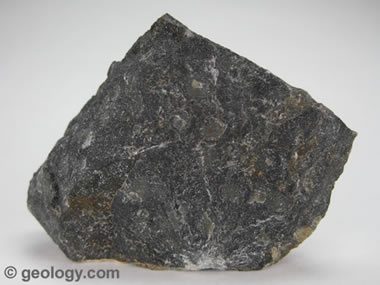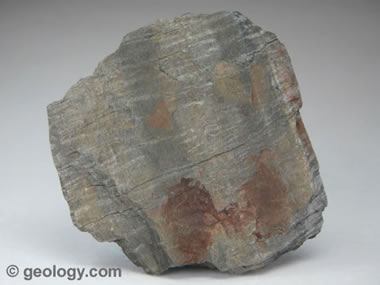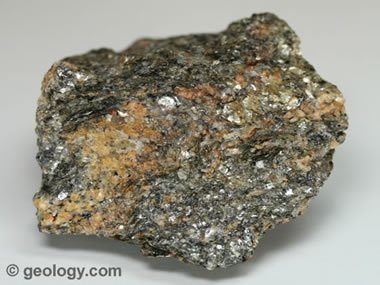Metamorphic rocks
have been modified by heat, pressure and chemical process usually while buried deep below Earth's surface.
Exposure to these extreme conditions has altered the mineralogy, texture
and chemical composition of the rocks. There are two basic types of
metamorphic rocks: 1)
foliated metamorphic rocks such
as gneiss, phyllite, schist and slate which have a layered or banded
appearance that is produced by exposure to heat and directed pressure;
and, 2)
non-foliated metamorphic rocks such as marble
and quartzite which do not have a layered or banded appearance. Pictures
and brief descriptions of some common types of metamorphic rocks are
provided below.
 Amphibolite
Amphibolite is a non-foliated metamorphic rock that forms through
recrystallization under conditions of high viscosity and directed
pressure. It is composed primarily of amphibole and plagioclase, usually
with very little quartz. The specimen shown above is about two inches
(five centimeters) across.
 Gneiss
Gneiss is foliated metamorphic rock that has a banded appearance
and is made up of granular mineral grains. It typically contains
abundant quartz or feldspar minerals. The specimen shown above is about
two inches (five centimeters) across.
 Hornfels
Hornfels is a fine-grained nonfoliated metamorphic rock with no
specific composition. It is produced by contact metamorphism. Hornfels
is a rock that was "baked" while near a heat source such as a magma
chamber, sill or dike. The specimen shown above is about two inches
(five centimeters) across.
 Marble
Marble is a non-foliated metamorphic rock that is produced from
the metamorphism of limestone. It is composed primarily of calcium
carbonate. The specimen shown above is about two inches (five
centimeters) across.
 Phyllite
Phyllite is a foliate metamorphic rock that is made up mainly of
very fine-grained mica. The surface of phyllite is typically lustrous
and sometimes wrinkled. It is intermediate in grade between slate and
schist. The specimen shown above is about two inches (five centimeters
across).
 Quartzite
Quartzite is a non-foliated metamorphic rock that is produced by
the metamorphism of sandstone. It is composed primarily of quartz. The
specimen above is about two inches (five centimeters) across.
 Schist
Schist is metamorphic rock with well developed foliation. It
often contains significant amounts of mica which allow the rock to split
into thin pieces. It is a rock of intermediate metamorphic grade
between phyllite and gneiss. The specimen shown above is a "chlorite
schist" because it contains a significant amount of chlorite. It is
about two inches (five centimeters) across.
 Schist
Schist is metamorphic rock with well developed foliation. It
often contains significant amounts of mica which allow the rock to split
into thin pieces. It is a rock of intermediate metamorphic grade
between phyllite and gneiss. The specimen shown above is a "garnet
schist" because it contains a significant amount of garnet. The small
crystals visible in the rock are small red garnets. It is about two
inches (five centimeters) across.
| Schist (Muscovite Schist) |
 Schist
Schist is metamorphic rock with well developed foliation. It
often contains significant amounts of mica which allow the rock to split
into thin pieces. It is a rock of intermediate metamorphic grade
between phyllite and gneiss. The specimen shown above is a "muscovite
schist" because it contains a significant amount of muscovite mica. It
is about two inches (five centimeters) across.
 Slate
Slate is a foliated metamorphic rock that is formed through the
metamorphism of shale. It is a low grade metamorphic rock that splits
into thin pieces. The specimen shown above is about two inches
